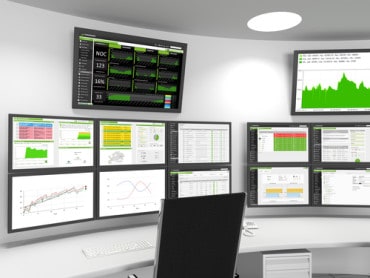
Many of today’s commercial properties already have high degrees of energy efficiency. However, even the most finely tuned heating and air-conditioning systems are subject to glitches and performance problems that may wash out any energy savings. RTInsights Industry Insights Editor Joe McKendrick explains how the deployment of real-time monitoring of energy usage helped one commercial real estate company prevent energy glitches.
Industry:
Commercial Real Estate
Location:
Washington, DC
Business Opportunity or Challenge:
Recently, three Washington, DC office buildings were introduced to real-time energy monitoring and alerting capabilities, which enabled building engineers to act on potential issues before they became costly problems. The Tower Companies (“Tower”), owner and operator of three large multi-tenant office buildings in downtown Washington, was able to realize substantial savings in the first 12 months of the implementation. The project was documented in a recent National Resources Defense Council (NRDC) report prepared by Philip Henderson of the Center for Market Innovation and Meg Waltner of NRDC.
How This Business Opportunity or Challenge was Met:
Tower engaged with AtSite, Inc., to provide the monitoring service. The key to the real-time monitoring was to detect and correct “operational drift,” which could add up if left unnoticed and unattended for extended periods of time. The initiative also included monitoring of heating or cooling to ensure the systems were activated within a four-degree range.
In one significant example, AtSite picked up an unusual pattern at one of the office buildings one day during the initial 12-month period. An analysis suggested that “both of the building’s chillers were cycling on for a few minutes at a time, then shutting off,” Henderson and Waltner recounted. “AtSite alerted the building engineer and, working together, the team found and corrected faulty variable-air-volume controls that were signaling the chiller to turn on even though the building management system called for the chiller to remain off.”
This issue would have eventually been detected and corrected, Henderson and Waltner pointed out. However, without real-time monitoring, the problem could have continued undetected for months. “This delay would have resulted in wasted energy, wear and tear on the building equipment, and possible disruption to tenants when equipment failed,” they wrote.
The second element of Tower’s initiative was engaging HVAC Concepts, Inc. (HVACC) to provide a detailed alarm service for building systems. Procedures were established “to remotely monitor certain systems settings, such as chilled water temperature, and to send messages to the building engineer if system conditions were outside defined parameters,” Henderson and Waltner explained.
The service provider “would follow up by phone or text message with the engineer to assure that red flags were addressed. While certain aspects of the monitoring service were automated, HVACC personnel had an escalation routine to engage Tower supervisors in specific instances,” they wrote. “HVACC also enabled Tower to quickly implement adjustments to BMS control routines or settings as needed to implement AtSite’s recommendations.”
Measurable/Quantifiable and “Soft” Benefits from This Initiative:
Tower’s real-time energy management initiative achieved a 13.2 percent reduction in electricity use across the three buildings. During the year-long study period, the real-time monitoring initiative led to an electricity savings of 23 percent at one location, 17 percent in the second, and seven percent in the third. The reduction in electricity expenses averaged $218,703 across all three buildings during this time. “Additional savings are expected from reduced maintenance expenses, and savings are expected to be persistent beyond year one,” they wrote.
Lessons Learned:
The real-time monitoring initiative that Tower undertook shows that “substantial gains are possible when building owners operate their buildings with attention devoted to reducing the amount of energy wasted,” Henderson and Waltner stated. Even better, this real-time energy monitoring initiative demonstrated that expensive retrofitting – such as adding more insulation in walls, installing tighter windows or exploring options such as solar power or thermal energy storage – are not necessary to produce long-term savings. The real-time monitoring system “focused on operational improvements – measures that do not require construction, disruption to an occupied office building or substantial capital investment.”
Building owners and operators “now have access to information about their building’s financial performance, operations, space utilization and energy consumption at the touch of a button,” observed Brandon Chase, analyst of AtSite and LEED Green Associate, in a recent white paper. “In the past, building owners and operators were at the mercy of retroactive data collection methods to learn about building performance. Monthly utility bills and manual meter readings could only indicate historical usage and lacked the ability to make operational changes in real-time.
“But with today’s enhanced virtualization and systematic analytics, these new tools enable owners and operators to see building performance in near-real-time, engineering staff to identify system drifts outside of ideal operations, and impact occupant behavior with interactive dashboards and engaging information.”
Sources: AtSite Inc.; Philip Henderson, Center for Market Innovation; and Meg Waltner, Natural Resources Defense Council
AtSite’s “Forgotten Element Building Performance” white paper
EDITOR’S NOTE: To submit a case study on behalf of your company, please see our Submission Guidelines and Template for Case Studies.
Want more on this topic?
Research from Gartner: Real-Time Analytics with the Internet of Things
From the Center to the Edge: The IoT Decentralizes Computing
For Manufacturers, IoT Means the ‘Internet of Tools’
Becoming an ‘Always On’ Smart Business
Liked this article? Share it with your colleagues using the links below!





























